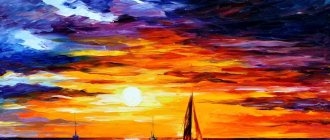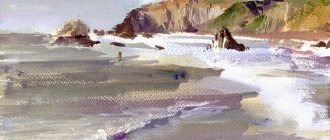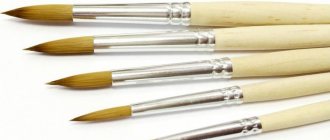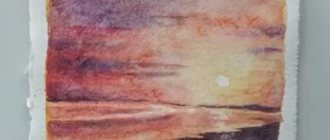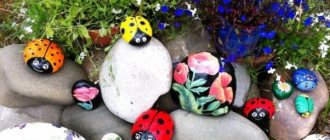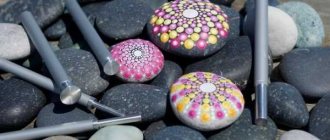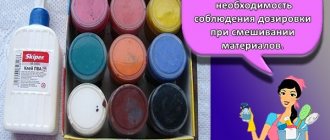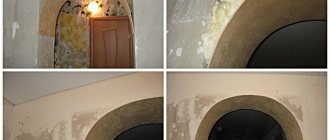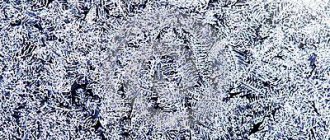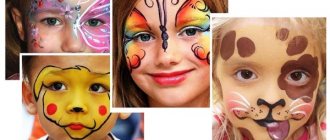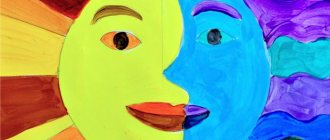Gouache is a glue paint. Its picturesque properties are based primarily on the fact that it is covering, i.e. almost opaque
. This is its main difference from watercolors, tempera and oil paints. This property is associated with a significant amount (relative to the content of the binder) of pigment and filler. In addition, for greater hiding power, many gouache paints contain white (lead, zinc, titanium, barite), which makes the dried paint somewhat whitish and at the same time gives it a matte and velvety appearance.
A few simple rules for drawing with gouache
Gouache paper
The surface for painting should absorb water, then the paint will adhere well to the surface, the layer will be even, and after drying it will not crumble. The best choice is thicker, rougher cardboard, such as cardboard for watercolors (depending on your taste, try different ones and draw on the one you like best). You can also draw on wooden and clay surfaces.
Brushes
You will also need different brushes - both flat and with thin tips, sizes - depending on the scale of the work. The larger the area that you will paint, the larger the brush should be, this is more convenient and faster. Brushes used in watercolors are suitable.
When choosing a brush for gouache, you need to be guided by the following: after making a stroke, there should be no “grooves” from the pile inside it. If they remain, the brush is very hard, but perhaps the gouache is too thick, see what is better - dilute the paint or change the brush. A hard bristle brush can be used if you need to get a specific stroke.
- Also in Myshop
- Products Sonnet
Palette
Gouache is not watercolor; you should not try to mix colors directly on paper as you paint (at least if you have little experience, although there is a technique for mixing two layers that allows you to create shades directly on paper).
To dilute gouache to the required state or mix paint to obtain the desired shades, you will need a palette. You can buy a plastic palette, or you can take a flat porcelain or disposable plate
– for whom it is convenient and what is at hand.
The paint is easily washed off with water
, and you can use the palette more than once.
You will also need...
It is better to take a larger container with water - the water quickly becomes dirty. Or put several jars.
A pencil, a soft eraser, a cloth for wiping the brush, and, if you have one, a tablet for securing a sheet of cardboard (especially convenient if you plan to wet the sheet with water, this will prevent it from curling).
What is gouache and its pros and cons
Gouache is a water-soluble adhesive-based paint with the addition of white. According to its properties, this paint is denser and more matte after drying, than, for example, acrylic or watercolor.
The technique of making gouache paints has been known since the Middle Ages, when it was used in Europe. The term itself originated in France in the 18th century (from the French Gouache - water paint).
Gouache paints are easily diluted with water and dry quickly. That is why they are preferred to be used in art classes at school and in the initial stages of learning to draw.
The paint has good hiding power and should be quite thick, so it is better not to work with this paint with glazes.
As I wrote above, gouache also contains white. This affects the color of the paint and the surface of the design after drying. The paint becomes more velvety to the touch, but the color also changes to a lighter color, different from what you see in the tube. Therefore, white should be used here with caution so as not to get too light a drawing.
Purpose
Gouache is great for abstract work, as it gives unusual shine and durability to paints, and color saturation. But the main advantage is the combination of the best qualities of watercolor, oil paint and acrylic:
- Artists love this paint because of its ease of use, fast drying, matte finish and fidelity;
- Graphs prefer it due to its opacity, expected results, and ease of use;
- Airbrushing uses an unconventional, dense, opaque coating and the ability to make adjustments without problems;
- Gouache in illustrations requires high detail, precise visualization, and almost photographic reproduction.
Gouache is ideal for precise brushstrokes, subject-oriented paintings in full color and black and white. Predictable quality, vibrant shades and fast drying combine to become a popular choice for designers and illustrators. Opaque qualities allow you to hide layers of detail, perform several layers when drawing, and get a flat surface of the painting that looks beautiful in photographs.
Gouache brushes
The brush, like the magic wand in Harry Potter, should be perfect for its owner. Where to start choosing brushes for painting and how not to make a mistake with your choice?
To do this, hold different brushes in your hands in the store - choose the one that is most comfortable to hold in your hands. Imagine how you will sit for hours and draw and hold it in your hands - you should feel comfortable and comfortable.
In my articles, I often advise trying to paint with different brushes of different shapes. But a lot will depend on your goals - whether you are drawing a poster on whatman paper or making a small drawing in an album. For these purposes you will need different brushes, of course.
For beginners, I advise you to purchase 3-4 of the most versatile brushes, and then purchase additional ones as needed of some other shape or size.
So, the brushes you will need for painting with gouache:
- Flat brushes
Used when filling the background with paint, to create broad strokes and fill in large details (for example, when drawing a poster).
- Round and oval brushes
Depending on the pressure applied, you can change the thickness of the pile and experiment with the shape.
- Thin contour brushes
They will be useful for drawing small details.
Depending on the type of bristles, do not choose brushes made from natural bristles that are too soft. For gouache, synthetic brushes and brushes with bristly bristles are more suitable. You can use kolinsky or goat wool from natural pile, as they are more resistant to external irritants.
You can find out more about choosing brushes for gouache painting, as well as ratings by manufacturer, in this article
Drawing flowers
Flowers are a beautiful creation of nature. Let's try to draw different flowers. Let's start with the simplest thing.
Tulip
This flower is associated with spring and is depicted on postcards dedicated to March 8th. Take a sheet of paper, paint and a pencil.
- Sketch a tulip. First just define it. Then you outline the bud, leaf, stem. Then you work through the sketch completely;
Stage 1
- Before coloring, erase any excess lines to avoid any dirt. Start coloring the bud and leaf. To make the shadow side and stem darker, cover with the same color again;
Stage 2
- Add black to red and create a border for the petals. And darken the parts that are in shadow. Use white to create a highlight where it is needed;
- Make droplets on the bud: draw small circles with dark red, and add a drop of white in the center.
Tulip
Two videos that show how to draw tulips:
Drawing tulips
Simple inflorescence for beginners
Drawing tulips
Tulip field is more complicated
Video lesson “Lilac”
Lilac
In appearance, lilacs are difficult to draw, as there are many small details. But this lesson explains in detail and shows how to draw at each stage.
Video lesson “Rose”
Rose
The most romantic flower can be easily drawn thanks to this tutorial. The author comments on his actions so that everyone can understand.
Surfaces you can paint on
Gouache paints can be used to paint on various surfaces. The most important rule is that they must be thick, including the paper on which you will draw.
- The simplest and most obvious choice is paper . Quite thick paper from 180 g/m2 will do. Also, whatman paper is well suited for gouache - it is thick, has a smooth glossy surface, and the paint will fit perfectly on such whatman paper. If you are not comfortable working with a large format, simply cut the Whatman paper into smaller pieces with a utility knife.
You can read more about choosing paper for gouache painting in my other article
- You can also draw on cardboard . Due to its density, it is ideal for gouache. It is better to take white cardboard with a smooth surface.
- If you have plywood , or just a sheet of it, you can use this surface. To do this, the gouache should be quite thick, you can even add a little PVA glue to it. It is advisable to varnish the finished work to secure the result.
- You can also paint on glass Remember that gouache is a water-soluble paint, and, for example, on dishes, such a design will not be preserved. But if this is some kind of craft, or window painting, then gouache is quite suitable - it can then be easily washed off, and the result can be fixed on the craft with the same varnish for decorative work.
- on fabric , since, again, this paint washes off easily and is not durable on things that will interact with water. For fabric, it is better to take special acrylic paint “for fabric”.
About gouache paints
Paint in jars delaminates over time: the bottom becomes much “thicker” than the top, sometimes a layer of liquid appears on top. You cannot paint with gouache like this, since the pigment in it is unevenly distributed. But it’s enough just to thoroughly mix the paint in the jar throughout its entire depth.
Paints of the “Master-Class” series (Master-Class gouache series) are paints of the highest quality, they are thickly ground, finely dispersed mixtures of high-quality pigments and binders. The brightness and purity of color, high light fastness of paints are due, first of all, to the use of high quality inorganic and organic pigments.
Manufacturer's VK: vk.com/nevskayapalitra
.
How to draw with gouache correctly
Gouache is a light paint that even a child can work with. It does not require any special rules or skills.
To know how to draw with gouache from scratch, remember these rules when working with it:
- Take a few cups of water to wet your brushes and not dilute the “dirt” in your paints.
- Take synthetic brushes of small sizes - flat and oval are suitable
- You can mix shades on a separate sheet of paper or plastic plate/palette
- Add whitewash little by little
- Take thick paper - from 180 g/m2
- The paint dries quickly - start painting with the background, and then add other details to the drawing
LiveInternetLiveInternet
Knights gouache
However, in the Middle Ages, in Europe, this material was widely used in painting miniatures, and not just for preparatory sketch work. In Russia, at the end of the 19th and beginning of the 20th century, serious works of easel painting were painted in gouache. It was during this period that gouache flourished.
Artists who have mastered this “frivolous” material to perfection create wonderful, elegant, uniquely velvety works. It is especially remarkable, with the help of gouache, to convey the unique atmosphere of evening twilight and foggy pre-dawn landscapes. Basically, gouache is an opaque watercolor. To work with gouache, there is no need for special thinners and drying accelerators, as when working with oil. When painting with gouache, there is no need to think about various auxiliary means (such as drying retardants, modeling pastes, varnishes, etc.). Gouache is a universal artistic material that allows you, with paint, water and paper, to master artistic techniques inherent in other materials. You can paint with highly diluted gouache using the watercolor technique, or you can master the writing techniques inherent in noble oil. Painting with gouache is comfortable, it does not have an unpleasant odor, does not require working with solvents, allows you to easily make changes to the drawing and does not require any special surface for painting (canvases, primers, etc.). That is why it is very popular in children's art and is widely used by beginning artists. Each of us painted the landscape in gouache. Gouache for beginners is also suitable for professionals.
squirrel gouache
There are several types of gouache: art, poster, acrylic and for children's creativity.
Types of gouache.
• Artistic gouache is ground pigments with the addition of distilled water, white and gum arabic. This gouache has excellent covering power, matte, velvety and fits perfectly on the artistic surface. For this type of paint, uncoated cardboard, watercolor paper, and tinted paper are ideal as a working surface. The first layer of paint is absorbed into the art surface, creating something similar to a primer. This allows the paint to adhere better to the work surface. • Poster gouache is just regular gouache, except that kaolin is used instead of white. This makes the paint brighter and denser. • Gouache for children's creativity contains cheap PVA glue instead of expensive gum arabic. This makes the paint less flexible and it dries faster. However, this makes it more resistant to shedding and abrasion. This paint is suitable not only for paper, but also for plywood, ceramics and canvas, which does not need to be primed with a special primer (as is the case with artistic gouache). PVA in gouache becomes an excellent fixative and successfully replaces special primer. Children's gouache drawings delight the eyes and hearts of parents. • Some manufacturers, with the advent of artistic acrylic, began to produce acrylic gouache. This gouache is suitable for painting any surface, and after complete drying it is not washed off with water.
Fairytale dragon castle in gouache
Properties of gouache and color features.
Many people consider gouache not convenient for drawing. If you have previously painted primarily with watercolors, then you only need to remember a few rules to get the same wonderful results when working with gouache.
Gouache paint is not transparent and contains white. This means that you need to write from dark to light, and not vice versa. That is, having decided on the composition and color scheme, you need to start with darker paint tones, and highlights and dark color accents are placed at the end of the work.
In order not to get confused about the possibility of mixing colors and shades, and also not to mess up with the color for shadows, it is better to have an idea of the color wheel that artists use. Colors lying in adjacent sectors of the circle mix with each other without the formation of dirt, and for shadows it is better to take a color from the opposite sector. This color is added in the required quantity to the main tone. More often, to depict shadows, they take: blue, green or purple. Under no circumstances should you add black color to the shadow image. You also cannot use black to obtain a darker tone of the same color; you will not darken the tone, but you will get dirt.
Among other things, you should know that gouache dries quite quickly. If you make a mistake, you cannot correct it until the gouache has dried. If you break this rule, you will end up with a smeared, dirty stain. You need to make changes and corrections to the drawing until the gouache layer has completely dried. Typically, drying time depends on the thickness of the gouache layer, it varies from 30 minutes to 3 hours. Once the gouache has dried, it is very easy to make changes. You just need to moisten the brush in warm, pigment-free water, lightly wring it out with a dry cloth and lightly wipe off the paint where the mistake was made. In the same way, you can shade an overly clear outline of a drawn object.
When mixing colors, you need to take into account that wet gouache is brighter. When it dries, it becomes white due to the presence of chalk in it. Therefore, you should always choose colors that are more saturated than those that you want to see in the final work.
gouache horse
Gouache brushes and brush stroke techniques.
Choosing the right brush will also help ease your familiarity with this art material. Since gouache is heavier and more viscous, overly soft brushes are not suitable for it, so it is better to put the light squirrel aside. The following materials are good for wet gouache: kolinsky, goat and synthetics. These brushes are great for shading, backgrounds and fills, that is, for working with a wet brush.
There are painting techniques that are suitable for working with a dry brush. How to draw gouache images of tree crowns, grass backgrounds, objects with an uneven or textured surface? In this case, it is better to use bristle brushes. The shape of the brushes will depend on the shape of the strokes. It is better to depict grass with flat brushes, and the crown of trees with round brushes. In this case, apply gouache diluted to the thickness of sour cream onto a dry pork bristle brush and make point blows with the brush on the working surface of the painting. This can be compared to pushing paint onto a work surface.
How to paint with gouache not only with brushes. You can apply paint using a foam sponge, special rollers or crumpled paper napkin. All this allows you to depict objects with a complex surface structure and achieve realistic depictions of many materials, such as rough ceramics or stone, or when painting a still life with gouache.
still life gouache
Painting techniques using gouache.
Gouache lessons.
There are two ways to create a background for gouache: • Evenly painting over the contours of a pencil sketch. First, the artist makes a pencil sketch on the artistic surface, and then spreads the primary colors as fills in the contours of the drawing. It is important to remember here that for the initial underpainting, the darkest tones of the drawing elements are taken. In order for the gouache to lay smoothly and without streaks, you need to pay attention to the size of the brush. The larger the contour being painted, the larger the brush should be. Gouache, in this case, should be diluted to the consistency of thin sour cream. You shouldn’t put too much pigment on your brush either; it’s better to wipe off the excess on the edge of the palette. You need to fill the contour without pressure, from one edge to the center, and then from the center to the other edge of the contour. This type of underpainting is not suitable for large surfaces. • For large surfaces, another type of painting is chosen - filling. In this case, first the background of the drawing is made, and then, on the dried background, the work itself is written. The background can consist of two or three primary colors in the gamut of the pattern. For example, when painting a landscape, they take: the color of the sky, the color of the earth, the color for the light stripe above the horizon. The sheet of paper is well attached to the tablet; it is better to glue all the edges with masking tape. Then the colors are distributed: the color of the sky at the top, the color of the earth below, the lightest in the horizon area. And then, until the paint has dried, smooth the paint using a wide, damp brush. The brush must be drawn without interruption, from one left edge of the sheet to the right, moving from the bottom of the work to the top. Then we wet the brush in water, shake off the excess, and smooth the paint from the top of the sheet to the bottom, moving the brush horizontally. In order for the background to be smooth and beautiful, training is needed. However, the result is worth the effort. When the background is smoothed out and the paint has not yet dried, the details of the hills are spread out with the darker paint chosen for the ground. After the main background and the formed landscape details have dried, vegetation, clouds and other details of the intended composition are painted.
gouache flower
Gouache paintings. Gouache painting techniques include:
• Glazing is a method that involves applying transparent layers of other tones over the base color. By covering the base color with translucent layers, a new deep shade is obtained. For gouache this method is available in the same way as for watercolor. You just need to dilute the gouache quite heavily with water so that it becomes transparent. Using the glaze technique, you can create a unique fog effect; gouache is suitable for this like no other material. • Impasto technique is also available in gouache. This technique involves applying thick, opaque paint to the work surface. This technique is inherent mainly in oil painting. Texture, light and shadow in paintings painted using the impasto technique depend not only on the color, but also on the shape and direction of the strokes applied. Gouache can also be used in this style, especially if it is PVA-based or acrylic. When working in the impasto technique and using ordinary artistic gouache, you need to remember that too thick a layer of this paint tends to crack and crumble after drying. Therefore, you need to very carefully add layers of thick gouache to the canvas in order to obtain the “golden mean” necessary for this technique and material. • There is another technique in which gouache can be used. It's called sgraffito. This technique is similar to engraving. Apply a layer of light paint to the paper and wait for it to dry. Then a thick, even layer of dark paint is applied. After the top layer has dried, take a drawing pen, a stylus, just a thick needle or a stationery knife, and paint with them, removing the dark layer of paint from the lower light layer. It is better that the top coat of paint is dry, but fresh enough so that the paint does not fall off. You need to act carefully, movements must be precise. • In addition, gouache is used beautifully in mixed media painting. For example, the background is made with gouache, and the drawing on the background is made with acrylic. Flowers made with gouache and acrylic are very impressive.
gouache sketch of a girl
Caring for tools when working with gouache.
You need to remember about the property of gouache to clog the bristles of soft brushes, so it is better to rinse the brushes immediately in a jar with plenty of warm water. To do this, you need to thoroughly rinse the brush, moving the bristles along the bottom of the container with water.
After finishing working with gouache, you need to rinse your brushes under warm running water. You also need to wash palettes with remaining paint, since dried gouache can paint over the palette, especially if it is plastic. Gouache dries very quickly, so all paint jars must be tightly closed. If you leave unclosed jars of paint after work, you risk finding there instead of soft, plastic gouache, fossilized pieces of dried pigment.
In addition, you need to monitor the condition of your paints. Gouache tends to thicken over time, even if you remember to cover it. This property of this material can lead to its complete drying. You can return the original quality to the drying material by dropping half a teaspoon of hot boiled water into the paint (this is enough for a standard small jar). Then the gouache should be closed and left for 30 minutes, after which it should be thoroughly mixed with a stick or the opposite end of a brush.
If your gouache has dried to the point of stone, then you can try to revive it, but this does not always work. To do this, you need to pour a little hot water into each jar, so as to cover the surface of the dried paint only by a couple of millimeters, and then put it in a warm place for three hours. In winter, a battery is suitable for this, and in summer, a sunny window sill is suitable. Then you need to mix the pigment thoroughly. If dried pieces still remain, you can try repeating the procedure described above. If this doesn’t help, then it’s all over with your paint and you can only throw it away. True, it can be used as a dry watercolor for sketches and rough sketches. Dried acrylic gouache cannot be revived; it turns into an insoluble, hard polymer.
I wish you creative success in working with gouache!
Artist Tips
- Always move from dark to light. For example, you have a dark background, purple, on which light objects are depicted - vases, fruits. Paint in the tone first, and then paint in the light objects, adding highlights at the very end.
- To paint with gouache you don't need a lot of water like you would with watercolor. Wet the brush a little in water - the paint should lie tightly on the surface.
- When mixing shades, use the Itten color wheel - it will help you avoid “dirt” and mixing the wrong color.
- Errors in the drawing can be corrected. To do this, wait for the paint to dry completely, then use a damp brush to remove unnecessary paint from the paper and paint it with a new color.
- Use bright colors. Since they will still become lighter after drying, do not use pastel shades so that the drawing does not seem faded.
Additional recommendations
A step-by-step method helps even children understand the basics of painting with gouache. Such lessons will allow you to master this wonderful creativity and learn how to paint in a certain sequence, choose the right paints to reflect the real beauty of nature, representatives of the flora and fauna on canvas.
To create pictures of nature, like drawings on any other topic, you need to start with a pencil sketch. It's easiest to draw by starting at the top of the canvas or piece of paper. As a rule, at the top is the sky, which is colored blue along the pencil contours.
Clouds are painted with whitewash, brushing white highlights across the blue sky.
Mountains are depicted in brown colors, and vegetation in green tones. The trees below are depicted in lighter or darker green gouache. The main thing is that the colors in the painting look like in reality. Paints can be mixed directly on the sheet, changing the water periodically. To create fine lines, you need to choose the right brush.
When using gouache, you must adhere to the following tips:
- You can buy gouache in tubes or jars; everyone chooses the most convenient packaging for themselves.
- The colors you need to choose are those that will be needed to work on the painting.
- Tests should be done on the palette, only after selecting the desired color, transfer it to the canvas.
- If the paint cracks, add a little gum arabic to it and stir thoroughly.
- To apply the next layer, you need to wait until the previous one has dried.
- It is advisable to coat the painting with varnish after drying.
Having mastered the technique of drawing, you can achieve success in artistic creativity. Moving step by step, from simple to complex, beginning artists gradually master the technique of painting with gouache. Below are video tutorials, the purpose of which is to help you depict the chosen plot on the canvas as accurately as possible. This step-by-step approach allows you to quickly learn how to work with paints such as gouache.
